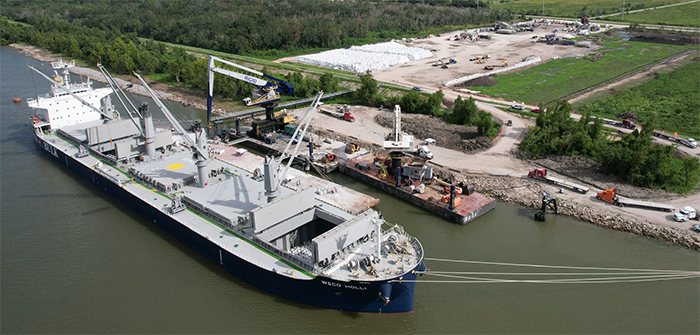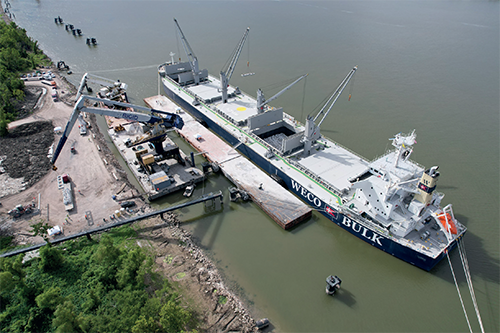
Nola Oil Terminal’s Chief Operating Officer, Christian Amedee, discusses the ongoing development of the $930 million terminal on the Mississippi River
Christian Amedee, Chief Operating Officer at Nola Oil Terminal (Nola), recognized a niche for a liquid terminal capable of efficiently storing and transferring petrochemical products into large vessels for export. Founded in 2010, Nola was originally permitted as a ten-million-barrel fuel oil terminal and storage facility. Post-foundation years saw dramatic changes to the industry though – the US lifted the ban on crude oil, and the Panama Canal expanded, allowing larger vessels into the Gulf of Mexico. Nola adapted to handle multiple materials, including crude oil and refined products. Christian obtained the first petrochemical permit in 42 years in lower Plaquemines Parish, making Nola the first fully permitted large industrial facility since Alliance Refinery was built in 1971.
Christian has since worked tirelessly and surrounded himself with skilled professionals to get the project operating. “Nola is still under construction, but we are very excited to have completed phase one of the project and be generating revenue,” he begins. The first of two phases has seen the construction of two deep water ship docks and one hybrid barge ship dock, and has been completed on time and within budget. These two Suezmax size docks are the only two of its kind ever permitted on the river. “Larger ships mean larger cargos, which results in higher profits and increased savings on shipping,” says Christian. This is especially true for Nola, as its dock is double the size of others on the river and able to load one million barrels of oil onto a single ship.
 Breaking strategic ground
Breaking strategic ground
Nola occupies a unique position on the Mississippi River. “Historically, the majority of oil-related facilities and refinery complexes are on the upper part of the river, but it is now pretty congested, with little space for new industry to come in,” explains Christian. “That’s why there’s huge growth in the Port of Plaquemines, and it has been a pleasure to be part of the industrial development there. The Army Corps of Engineers is building a 100-year, storm-event protection levee in South Plaquemines, which I believe was the catalyst for the land rush in Plaquemine’s Parish over the last five years. Plus, it has strategic advantages – closer to the Gulf of Mexico and the river is both wider and deeper – so it really is the last of the untouched strategic ground.”
Early in the construction of the terminal, Christian noticed a potential opportunity to utilize the southern portion of the property for construction services. He explains: “We have been assisting two other industrial facilities in construction related services. I had permitted a conveyor system for offloading aggregate, originally for our own usage to keep trucks off the highways and increase safety. But this conveyor system came into demand with the industrial complexes around us, and we’ve been moving millions of tons of aggregate through this system for our own purposes and for our neighbors.” Prior to this, trucks had to make 50-mile trips to deliver aggregate, but Nola is supporting local construction by being the most accessible port on the river and providing safer solutions. “Nola gives its users the ability to transport via marine and offload within a few miles of the sites, which simultaneously minimizes overall trucking costs and increases safety. Also, it greatly mitigates the liability associated with truck traffic on local state highways. It was a great opportunity for us to generate some revenue whilst still under construction. It’s a great foundation to start developing the tank farm on the northern end, working our way south, and put the extra acreage to use before we can develop it ourselves,” adds Christian. Nola has dedicated around half of its land to construction services and is already bringing in 300,000 tons of aggregates and limestone every month. It has also recently brought in 125,000 tons of Portland cement for two local plants.
In the pipeline
The second phase of the project, which started at the beginning of the year, includes the construction of another barge dock, as well as large scale land-based storage facilities. The storage facility aims to achieve a capacity of up to ten million barrels with on-site blending, storage, and transfer amenities. However, the success of the construction services during the first phase of the project has resulted in an additional objective for the second – to increase the efficiency of offloading construction materials. Nola plans to do so by constructing a large vehicular platform, more conveyors, and various associated landside infrastructure. “Right now, we’re having to somewhat double handle the heavy cargo with two different crane systems, but we are building a 65-by-500-foot platform that will allow us to drive the truck right up to the ship and offload cargo directly. This will double our efficiency and eliminate extra handling of the material, so we’re very excited to get construction of the platform underway.”
Moving forward, Christian concludes that, “the upper portion of the property will continue its oil related buildout. Offloading of materials and other construction services seems to be growing, so we are expecting a good combination of both this year. It’s looking like 2023 is going to be a great year for us!” Thinking further ahead, he proposes: “I think the construction related business will start to decline in around five years’ time. The tank farm will then start to move south and eventually will have the full ten-million-barrel terminal with docks and connecting pipelines in operation.”
www.nolaoil.com